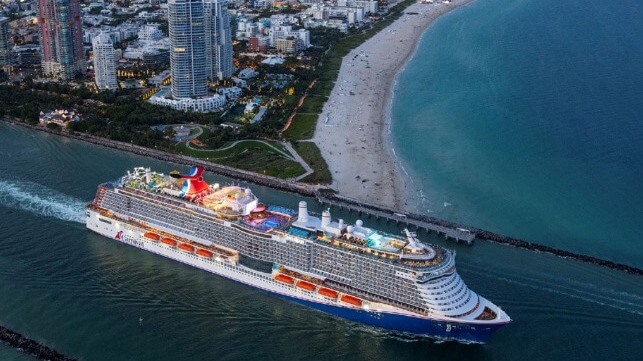Carnival Beats Projections as Cruise Recovery Reaches Inflection Point

Carnival Corporation reported second quarter results exceeding its prior guidance and marking what management is calling an “inflection point” for the industry as they pass the peaks of 2019 before the pandemic. While still reporting a financial loss, management pointed to setting records in bookings, deposits, and continuing strong demand, saying that they believe the company is on track to beat guidance for the year and it marks a key point in the return after the pause due to the pandemic.
Among the key indicators the company is highlighting in its recovery is that total bookings made during the quarter across its eight brands reached a new all-time high with a continued acceleration of demand. This led to total customer deposits reaching an all-time high of $7.2 billion, surpassing the previous record from 2019 by over $1 billion.
Operations on the ships were also strong and while occupancy remains behind 2019 levels at 98 percent, the corporation set a record for second quarter revenue ($4.9 billion). Driven according to the analysts in large part by an increase in onboard spending, operating income turned positive for the first time since the resumption of cruise operations and marking what Carnival called “a significant milestone.”
"We reached a meaningful inflection point for revenue this quarter, with net yields surpassing 2019's strong levels, and we achieved positive operating income, cash from operations, and adjusted free cash flow," said Josh Weinstein, Carnival Corporation & plc's Chief Executive Officer, commenting on the results. "With bookings and customer deposits hitting all-time highs, we are clearly gaining momentum on an upward trajectory.”
Carnival points to key steps taken to manage its capacity and realign elements of its brand portfolio noting that operations in both the U.S. and Europe showed strong momentum this quarter. Following the portfolio and fleet optimization efforts, management highlights that capacity growth has been concentrated in its highest returning brands, Carnival Cruise Line, AIDA, and P&O Cruises UK. Carnival Cruise Lines’ capacity, for example, is growing 22 percent more than pre-pause expectations, while Costa’s capacity is being reduced by 36 percent, compared to pre-pause expectations. A large part of this was the decision to remove the brand which had been the first international company into China more than a decade ago from the market. Responding to analyst questions, Weinstein says the near-term intention is to remain on the sidelines with China even as the once prosperous market reopens.
The company is happy with its current deployments saying it believes it has ships in the right markets while also noting that there remains excitement from 14 newly delivered ships representing nearly a quarter of the corporation’s capacity.
Full-year 2023 occupancy is expected to be at 100 percent or higher, said CFO David Bernstein noting that they continue to close the gap each quarter on occupancy levels as compared to 2019.
"Based on continued strength in pricing, we delivered out performance in the second quarter and raised our expectation for revenue in the second half,” Weinstein told investors. He said that coupled with the interest expense benefit from deleveraging they are expecting strong results for the second half of 2023 and moving forward.
After spending the past few years focused quarter-to-quarter on the recovery, John Weinstein also highlighted a new long-term focus with a three-year effort called SEA Change. Focusing on the three years between 2023 and 2026, he outlined efforts for a more than 20 percent reduction in carbon intensity compared to 2019, while driving a 50 percent increase in EBITDA to the company’s highest level in almost two decades. Finally, for the investors he committed to more than doubling adjusted Return on Invested Capital, which would also come in at the highest level in almost two decades.
